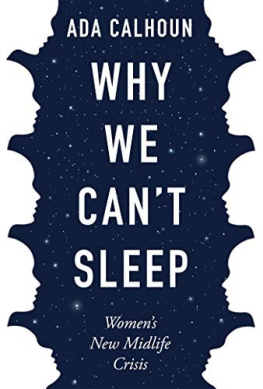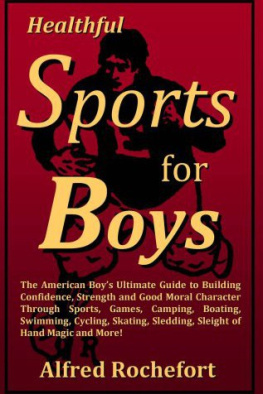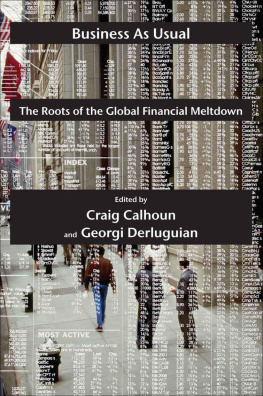Wedding Toasts Ill Never Give
St. Marks Is Dead
WHY WE CANT SLEEP
Womens New Midlife Crisis
ADA CALHOUN
Copyright 2020 by Ada Calhoun
Cover design by Becca Fox Design
Cover illustrations: night sky alexkoral/Shutterstock;
faces essl/123rf
All rights reserved. No part of this book may be reproduced in any form or by any electronic or mechanical means, including information storage and retrieval systems, without permission in writing from the publisher, except by a reviewer, who may quote brief passages in a review. Scanning, uploading, and electronic distribution of this book or the facilitation of such without the permission of the publisher is prohibited. Please purchase only authorized electronic editions, and do not participate in or encourage electronic piracy of copyrighted materials. Your support of the authors rights is appreciated. Any member of educational institutions wishing to photocopy part or all of the work for classroom use, or anthology, should send inquiries to Grove Atlantic, 154 West 14th Street, New York, NY 10011 or permissions@groveatlantic.com.
FIRST EDITION
Published simultaneously in Canada
Printed in The United States of America
First Grove Atlantic edition: January 2020
This book is set in 12-point Dante MT
by Alpha Design & Composition of Pittsfield, NH
Library of Congress Cataloging-in-Publication data is available for this title
ISBN 978-0-8021-4785-1
eISBN 978-0-8021-4786-8
Grove Press
an imprint of Grove Atlantic
154 West 14th Street
New York, NY 10011
Distributed by Publishers Group West
groveatlantic.com
20 21 22 23 24 10 9 8 7 6 5 4 3 2 1
For the middle-aged women of America.
Youre not imagining it, and its not just you.
Award-winning journalist Ada Calhoun is the author of Wedding Toasts Ill Never Give, named one of Amazons Best Books of the Month and one of W magazines top ten memoirs of 2017; and St. Marks Is Dead, one of the best books of 2015, according to Kirkus Reviews, the Village Voice, and the Boston Globe. She has written for O Magazine, National Geographic Traveler, and the New York Times.
Contents
Most of the women in this book appear here by first name or anonymously. I wanted to help them feel safe speaking with candor about their marriages, their bank accounts, and their night sweats. However, because they are members of Generation X, I can reveal that quite a few are named Jenny, Amy, or Melissa.
Except where relevant, I do not call attention in the book to these womens race, sexuality, or other demographic markers, though they do mirror the makeup of the country. They are single and partnered, mothers and childless, black and white and Asian and Latina, gay and straight, liberal and conservative, evangelical and atheist, and they hail from nearly every state, including Alaska.
I found them through friends, calls sent out from O Magazine s social media accounts, experts in a variety of fields, and online message boards, as well as at professional conferences, playgrounds, doctors waiting rooms, churches, and bars.
They live in the country, the city, and the suburbs. They work, dont work, did work, will work, and have careers that include photographer, priest, tech executive, lawyer, doctor, teacher, and telephone company manager. They range in dress size from 0 to 28+. Some are having an okay time of middle age; many are struggling in one way or another. Some feel on the verge of, as one said, blowing it all up.
I did limit my reporting in two ways: first by age, of course. Second: by class. Very poor women in this country bear burdens that are beyond the scope of a book this size. Very rich women have plenty of reality TV shows about them already. I focused on women who, by virtue of being middle class, grew up with reasonable expectations of opportunity and success.
Each chapter opens with a keynote quote. These were lines spoken to me by eleven different women whom I found representative of many others. In this polarized era, I found it reassuring, if also a little depressing, to discover how much we have in common at this age. Regardless of politics, race, and region, American Generation X women share a host of cultural touchstonesfrom the theme songs for shows like The Facts of Life When the world never seems / to be living up to your dreams!to memories of where we were when the Challenger exploded. And we share a daunting set of similar circumstances.
It was an honor to conduct these interviews, which often turned emotional as women discussed their fears and regrets. One woman started crying the moment I asked if I could speak with her about her experience of midlife. I was afraid Id said something wrong. Was she mad that Id implied she was middle-aged? No, the tears came from shock, because shed been feeling so invisible. She said, No one ever asks about me.
You come to this place, midlife. You dont know how you got here, but suddenly youre staring fifty in the face. When you turn and look back down the years, you glimpse the ghosts of other lives you might have led. All your houses are haunted by the person you might have been. Hilary Mantel, Giving Up the Ghost
One woman I know had everything shed ever wanteda loving partner, two children, a career she cared about, even the freedom to make her own schedulebut she still couldnt shake a feeling of profound despair. She spent months getting a babysitter for her toddler daughter in the middle of the day, using the time to go alone to noon movies, where she sat in the dark and cried.
A former coworker told me that her impressive LinkedIn profile was misleading. In truth, she was underemployed and for years since her last layoff had been taking one low-paying gig after another. Shes unmarried, never had kids, and while that part is okay with her, she has started dreading her upcoming fiftieth birthday, having realized that she will probably never own her own home and has saved nowhere near enough for retirement.
A neighbor with a small army of adorable young children was doing part-time work she enjoyed. Her kids father was a friendly, hardworking man. She was baffled by the rage she had come to feel toward him. Shed begun to imagine that divorced she might have a better shot at happiness. Id leave, she said to me one day when I asked how things were going, if I had more money.
Another woman told me she had started to fear that she would die alone. Just like her married friends, shed gotten a good education and had a good job, had made a nice home and was staying in shape. But somehow shed never found a partner or had children. She woke up in the middle of the night wondering if she should have married her college boyfriend, if she should freeze her eggs, if she should have a baby alone, if she should do more or less online dating, and just how much more she could take of her friends sons and daughters smiling on social media before she threw her laptop out the window.
An acquaintance told me shed been having a rough time, working at three jobs as a single mother since her husband left her. Determined to cheer up her family, she planned a weekend trip. After a long week, she started packing at 10:00 p.m., figuring she could catch a few hours of sleep before their 5:00 a.m. departure. She asked her eleven-year-old son to start gathering his stuff. He didnt move. She asked again. Nothing.
If you dont help, she told him, Im going to smash your iPad.
He still didnt move.
As if possessed, she grabbed a hammer and whacked the iPad to pieces.
When she told me this, I thought of how many parents I know who have fantasized or threatened this very thing, and here she had actually done it. I laughed.
Yeah, my friends think its a hilarious story, too, she said. But in reality, it was dark and awful. Her first thought as she stood over the broken glass: I have to find a good therapist right now.
Next page









